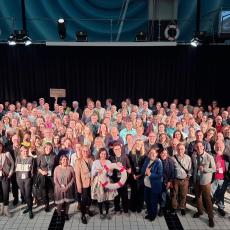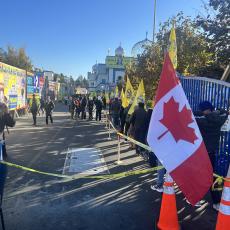Can locals address haze in a northern Thai city?
This story was first published by Asia Democracy Chronicles. Illustration credit: Asia Democracy Chronicles
They can see clearly now in Chiang Mai, the rains have come. And for the next several months at least, residents and visitors to Thailand’s premier city up north can once again enjoy its scenic mountain views and colorful local culture, as well as breathe in fresh air.
But most people now know this idyll is not going to last.
For the past several years, Chiang Mai has been battling with seasonal haze that lasts for months at a time. Once seen only during January to April or Thailand’s normal dry season, the haze now descends on Chiang Mai as early as December sometimes. This year, it even lasted until early May.
According to Prime Minister Srettha Thavisin, the situation was actually better than the year prior. Yet in the three weeks from mid-April to the end of the first week of May, the Swiss tech company IQAir had Chiang Mai among the five most air-polluted major cities in the world.
Noticeably, government and public interest in the matter seems to be seasonal as well.
The local clearing of forests mainly to ease the collection of mushrooms, herbs, and honey, as well as to simplify hunting appears to be the major cause of the seasonal haze. Agricultural burning is another significant contributor. But while both of these practices have been done for generations, some have argued that these have escalated in recent years as the traditional community stewardship declined, as had state monitoring.
In fact, some state agencies and offices – including that of the Prime Minister – have been sued in court by nongovernment organizations, activists, academics, medical professionals, and Chiang Mai residents to force them into action. As a July 2023 BangkokPost editorial pointed out, “The complaints and demands included in these legal petitions explain more about how remiss our national and local governments have been.”
Some suits have resulted in decisions in favoring the petitioners. Yet in such instances, the government has been quick to file appeals instead of following court orders or simply trying to look for solutions.
Just last January, a Chiang Mai court ordered the National Environment Board (NEB) and the Prime Minister’s Office to come up with an emergency pollution mitigation plan for Chiang Mai within 90 days. The NEB filed an appeal, which has been granted by the Supreme Administrative Court.
A problem that comes and goes?
A mix of individuals and organizations in Chiang Mai filed the class-action suit in April 2023 against NEB and company, which had included the Securities and Exchange Commission and the Capital Market Supervisory Board.
Surprisingly, though, there have been no major street protests in Chiang Mai over the issue – or even against the NEB’s successful appeal.
In fact, the locals have been exceptionally patient, despite the haze possibly cutting their life expectancy by decades. (The average life expectancy of Thais in general in 2023 was about 78 years. According to one study, the “average number of years living with disability due to ambient PM2.5,” a fine particulate that is a large part of the haze in northern Thailand, is 41.4 years; with PM10, another fine particulate, it is 59 years.)
This seemingly placid attitude among many locals could be explained by a couple of key factors.
First, Chiang Mai province is the heartland of Pheu Thai, the dominant party in the ruling coalition, and the birthplace of Pheu Thai founder Thaksin Shinawatra, the ex-convict-cum-ex-premier who is still on parole. This means the majority of the people there are most sympathetic to the current government – whose head even visited Chiang Mai in the middle of last March – and have little desire to oppose or undermine it.
Then there is the perception that it is a “seasonal” crisis that is also linked to forest fire and not just man-made fire. The prevailing attitude thus is that the problem is mostly beyond the control of the government, and that being seasonal, this too shall eventually pass, so one simply needs to be patient.
This could also be why there is yet no organized group of citizens or lobby group working specifically on the issue of PM2.5 microdust pollution in Thailand, despite the national capital also suffering from it.
To be fair, the current administration has not been totally oblivious to the issue. In January, then Public Health Minister Cholnan Srikaew conceded that the health of 56 million Thais is affected by the invisible PM2.5 microdust. But then he suggested that those with allergies or groups who are at higher risk of developing health problems because of the haze should build a dust-free room equipped with an air filter – an option possible only for a small, moneyed segment of the population.
The government has also tried to dissuade farmers from burning agricultural waste to prepare the land for the next crop. But such an effort has had little success. Meanwhile, the government has done next to nothing to discourage or penalize big agribusinesses that work with contract farmers in Thailand to grow cash crops for animal feeds, particularly maize and cassava. Many of these farmers practice agricultural burning, a major factor causing the haze.
Across the border, in Myanmar, Laos, Cambodia, and even Vietnam, satellite images of heat spots remind Thais that the problem is not just local, but also transborder. Yet again, Thai agribusiness monies have been behind a significant chunk of the cash crops planted there, which later generate agricultural waste that ends up being burned and contributing to transboundary pollution. That may be one reason why the Srettha government has not made much progress in convincing neighboring countries to stop the harmful practice.
Tourism over respiratory tracts
Back in Thailand, for all the Prime Minister’s declarations of this year’s haze not being as bad as 2023’s, some Thais had debated whether or not Chiang Mai province, which includes its namesake city, should declare a state of calamity so state resources can be better mobilized. In the end, the government decided not to do so, fearing such an announcement would dissuade foreign tourists from visiting the famous resort city.
The provincial government, for its part, experimented with a work-from-home setup for three days, from April 9 to 11. Then it quietly stopped promoting the setup, despite persisting air pollution that had people who ventured outside gasping, tearing up, and itching.
Aside from nosebleeds and skin and eye irritations, respiratory and cardiovascular problems have been observed among those exposed to air pollution. Citing the Ministry of Public Health, the online publication Thai PBS World said in a report that between January and the third week of February this year, more than 650,000 people received treatment for illnesses linked to the haze, and particularly to PM2.5.
Even the Shinawatras proved to be no match to the haze. According to Bangkok Post, members of the powerful clan, including former premier Thaksin, fell sick with respiratory illnesses soon after visiting Chiang Mai last March.
More recently, the Post said that based on research by Chiang Mai University (CMU) academics, worsening PM2.5 pollution in Thailand’s northern region has been “leading to a surge in patients suffering from lung diseases,” including lung cancer. The university has lost four of its lecturers to lung cancer since 2022, Bangkok Post said, among them CMU’s former architecture dean, Professor Rawiwan Olarnratmanee.
“Test results indicated the cancer cells found in her lungs bore genetic mutations attributable to PM2.5 exposure,” the Thai daily said.
Last December, 29-year-old physician and CMU lecturer Krittai Thanasombatkul succumbed to lung cancer as well. Colleagues suspect PM2.5 exposure as also among the factors causing the exercise-loving doctor who didn’t smoke to develop the disease.
CMU Faculty of Medicine Associate Professor Chalerm Liewsisakul told the Post that comparative data covering 2010 to 2021 revealed the northern provinces, particularly Chiang Mai and Lampang, as having the highest death rates from cancer. The daily quoted Chalerm as saying that this grim reality highlighted “the urgent need for targeted interventions to address air pollution and its health consequences in these areas.”
As the haze was building up last January, Thai legislators did finally endorse a bill addressing the country’s air pollution problem. The Srettha government has also said it will include it among its priorities, but not much has been heard of it since.
Nothing may be heard about it again – until the next haze causes another season of chaos and choking.



